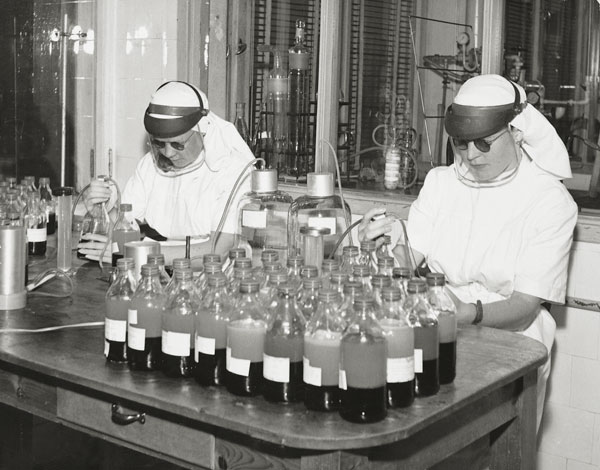History of Blood Service
The Finnish Red Cross Blood Service (FRCBS) was founded on 1 January 1948 to satisfy hospitals’ blood demand. Just like 75 years ago, blood plays a leading role in saving and improving the quality of life.
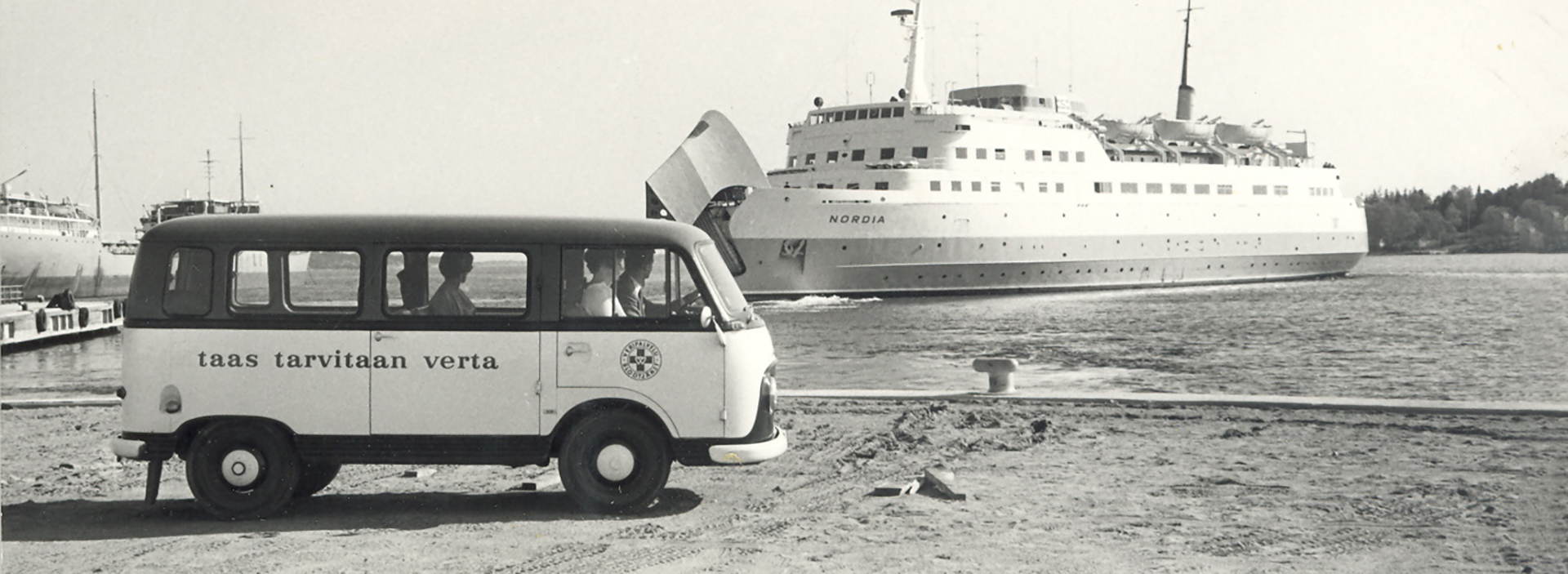
History of blood transfusions
Blood transfusions have been conducted for hundreds of years. Initially, blood transfused to a patient originated in animals. For example, it was believed that the docile nature of a lamb would be transferred to humans by being carried in the blood.
The history of blood transfusions began properly in the nineteenth century. In the early 1800s, Englishman James Blundell concluded that blood from animals was unsuited for humans. He recommended that humans be given blood from other humans. By the end of 1850, the number of recorded blood transfusions totalled 44. At the time, it was noted blood transfusions were “one of the safest surgical operations as the mortality rate was only one of three patients.”
The prerequisite for safe blood transfusions were created in 1900, when Austrian Karl Landsteiner discovered the ABO blood groups. Three decades later, Landsteiner was awarded the Nobel Prize for his discovery.
The first blood transfusion in Finland was conducted in 1913. It was performed by Richard Faltin, docent in surgery, at the surgical clinic of the Helsinki General Hospital. The leading figure among doctors performing blood transfusions in Finland in the 1920s was Ludvig Lindström, Senior Medical Officer at the Vaasa City Hospital. At the Vaasa City Hospital, blood transfusions were routinely conducted earlier than at other hospitals.
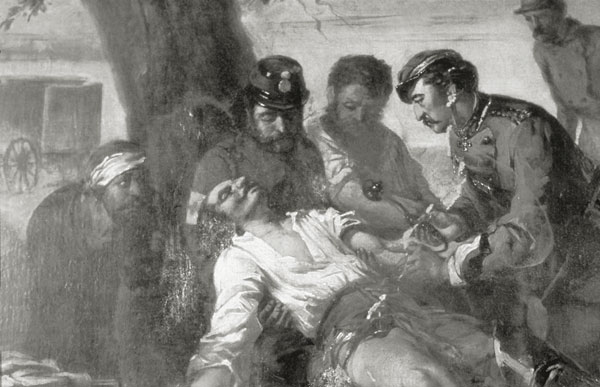
History of Blood Service
The Blood Association of the Guides and Scouts and the Blood Service of the Finnish Defence Forces In Finland, donating blood has always been voluntary and donors do not receive payment in exchange for blood. The Scouts brought the idea of voluntary blood services from England to Finland in the 1930s, founding the Blood Association of the Guides and Scouts in 1935. The Association had approximately four hundred members when it was at its largest.
Before the Winter War, blood transfers were conducted on a relatively small scale at Finnish hospitals, with the donors being mostly the patients’ relatives. Scouts donated blood when no relatives were available for donation.
During the war years, the need for blood increased. The Blood Service of the Finnish Defence Forces continued the work that the scouts had started, assuming responsibility for recruiting blood donors and for the collection of blood during the period from 1939 to 1944. During the Winter War of 1940, the practice of donating blood into glass bottles was assumed, in order to avoid cumbersome direct transfusions. During the war years, a total of 190 000 bottles of blood was donated.
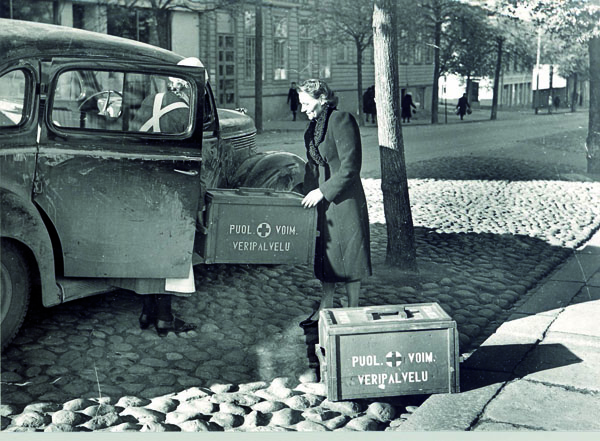
The Finnish Red Cross Blood Service was founded
After the war, many people believed that blood would not be needed in peace time. However, developments in treatments led to an increased need for blood. Consequently, Finland needed a blood service organised on a nationwide basis.
The Finnish Red Cross Blood Service was founded in 1948 to serve the blood service needs of the whole country. The Blood Service has always been based on the voluntary, unpaid activity introduced by the scouts. Harri Nevalinna, a young doctor, was appointed to manage this work. He remained in this post for 40 years, until 1988.
Work was begun to build the office network of the Blood Services in connection with the hospitals, with already 16 offices in operation by the end of 1948.
The first mobile blood donation session in Finland was arranged in Ruotsinpyhtää in 1951. The mobile blood collection service was extended to cover the whole of Finland by 1954, with blood donation sessions being arranged at workplaces, in garrisons and at educational institutes. From the very beginning, volunteers representing the local Red Cross chapters have provided invaluable help at the donation sessions.
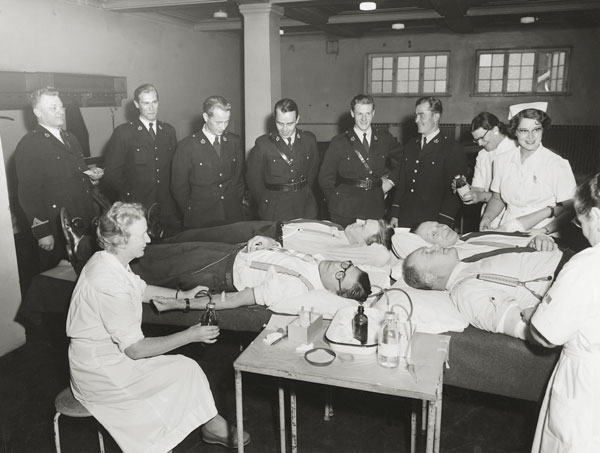
Blood in a bottle and bag
The first blood transfusions conducted in Finland were direct. The patient and the donor were lying on adjacent beds, with the blood being transferred in a tube from vein to vein. During the war, direct transfusions had to be rejected for practical reasons.
In 1940, Vichy bottles were adopted for blood collection. Around ten years later, the Blood Service introduced glass bottles in compliance with a Nordic standard, containing a citrate solution to prevent clotting of the blood.
Blood was collected for the first time in plastic bags in Finland in 1957. Plastic bags gradually replaced glass bottles in the 1960s. At the same time, component therapy was introduced in treatments, as blood donated in plastic bags could be separated into red cells, platelets and plasma using a centrifuge. The patient only receives the necessary blood component required in his or her treatment. Thus, blood transfusions became more effective and safer.
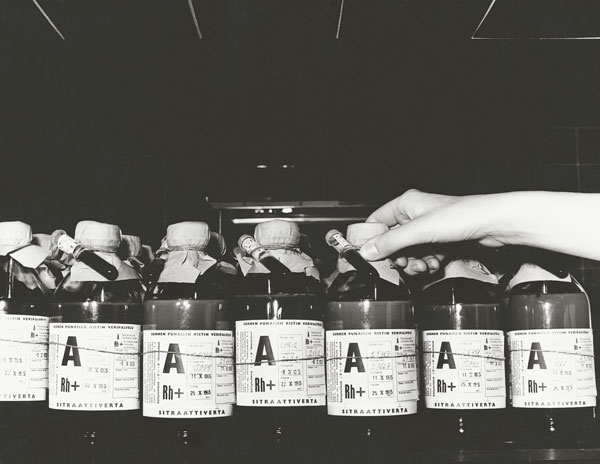
Research guaranteeing the future
Harri Nevalinna, the first head of the Finnish Blood Service, was both a doctor and a scientist. Research soon became a natural and integral part of the Blood Service operations.
In 1957, the Blood Service began research on clotting factor tests targeting patients with haemophilia. Since then, the Blood Service has conducted ground-breaking research on blood groups, on tissue and organ transplants, and on stem cells.
With the help of its research and development efforts, the Blood Service will be able to offer new and increasingly safe products for the benefit of Finnish healthcare. The most recent innovations include the cell production centre, completed in 2012, where cell products are developed for the treatment of diseases.
